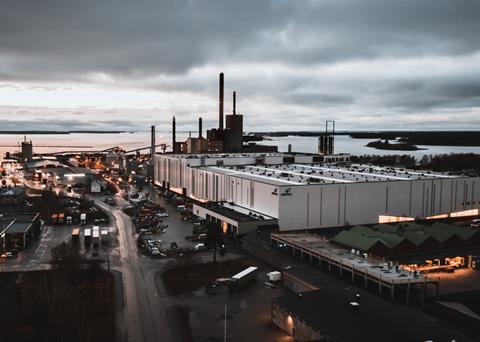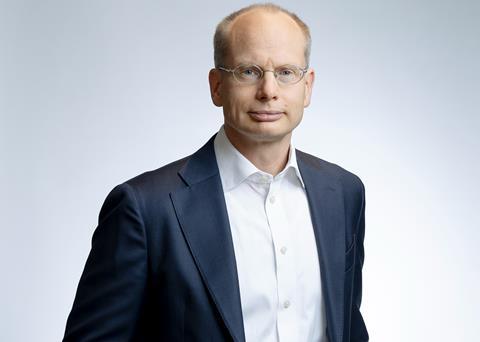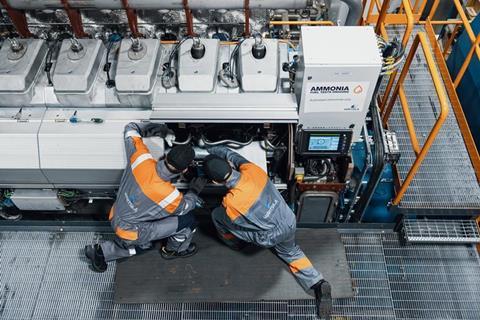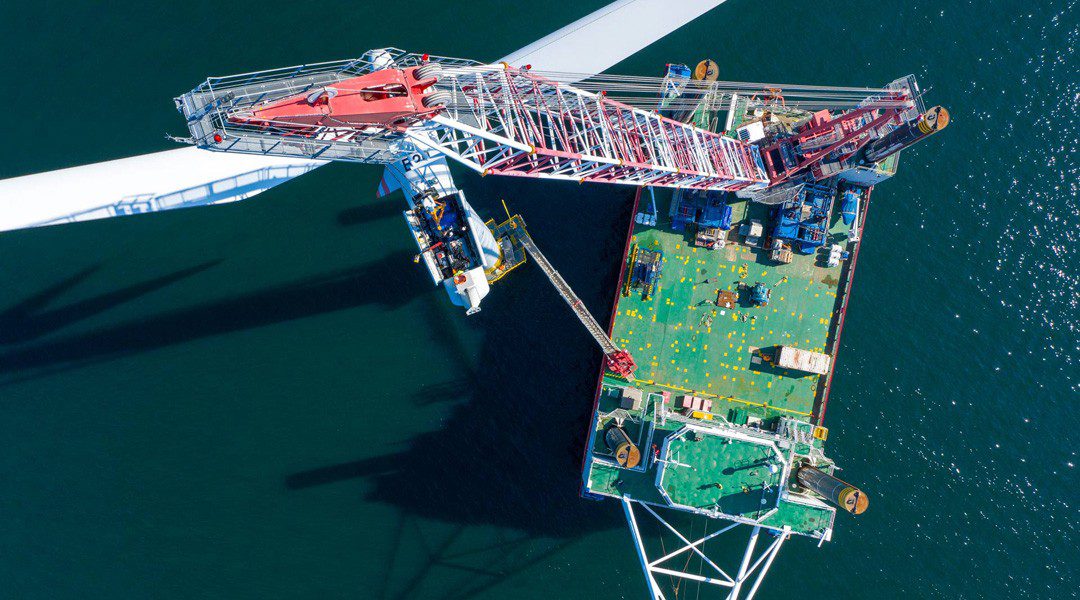President and CEO of Wärtsilä Håkan Agnevall outlines the company’s strategy to the energy transition in the maritime sector in an exclusive interview with The Motorship
Mr. Agnevall began by noting that his appointment as President and CEO of Wärtsilä represented the culmination of a personal journey. Having progressed from energy transmission at ABB through rail transportation at Bombardier and passenger transportation at Volvo Buses, where he was president, “it was obviously time for ships.”

Source: Wärtsilä
The new Smart Technology Campus at Vasa will open before the end of 2022. Mr. Agnevall notes that it is “probably the most significant investment we’ve ever made in Wärtsilä.”
Mr. Agnevall is the epitome of a modern chief executive, with an international background spanning the Americas, Asia and Europe, and managerial experience across a range of functions, including sales, engineering and project management. It is clear that Mr Agnevall has a passion for R&D and the transformative potential of different technologies. “I really enjoy this intersection between technology, people and society.”
Another of Mr. Agnevall’s interests is in using technology to break down barriers, both between teams within the company externally, and also in developing closer working relationships with suppliers and customers. This was a theme that he returned to later in the interview, where he outlined some of the changes in working methods that Wärtsilä will pioneer at its Vaasa campus by the end of 2022.
Another common thread running through Mr. Agnevall’s career has been entering industries just before or just as significant technological transformations occur. This was no accident, but rather a deliberate choice. “I’ve been looking for those types of transformations, because you really can make a difference. Coming together as a team, in a [time of] transformation for a business and an industry, you invest a lot of yourself, your passion, your time, and it’s also very rewarding because you can really see the results.”
Mr. Agnevall offers a glimpse of that passion when he describes, with obvious satisfaction, the widespread scepticism that greeted a decision by Volvo Buses to exhibit an electric bus prototype at a trade show in 2013. “At the latest UITP [trade fair] in 2019, all of the bus models exhibited in the whole fair were electric,” he adds simply.
The wider industry
Returning to the theme of transformation, Mr. Agnevall is unequivocal that a similar change is also underway in both the wider energy sector, and in the maritime transportation sector.
Show Fullscreen

Source: Wärtsilä
President and CEO of Wärtsilä Håkan Agnevall: “In my view, more is going to happen in the maritime sector, and also the energy sector, quite frankly, over the coming decade, than in the preceding 30 to 40 years.”
“In my view, more is going to happen in the maritime sector, and also the energy sector, quite frankly, over the coming decade, than in the preceding 30 to 40 years.”
The changes were going to be driven by the response to the dominating question facing the industry at the moment. “How do we create a sustainable path to meet the Paris Agreement and really address CO₂?”
Mr. Agnevall speaks concisely, and elegantly sketches out the main drivers of the transition and some of their likely consequences in succinct sentences. Shifts in the regulatory environment, and both EEXI and CII in particular, will have an effect on the industry. “Especially with CII, with its requirements for continuous reductions, we clearly see that is having an impact on ship operators and owners and how are they going to decarbonise their fleet going forward.”
The unfortunate likelihood of regional diversification in the regulatory environment was recognised. In fact, the EU’s Fit for 55 proposals, and incorporation of shipping into the EU’s ETS are likely to be just the starting point. “There will be regional regulations or country wide regulations affecting maritime going forward.”
However, Mr. Agnevall balances out the challenges by noting that a nascent market for green transport represents an emerging business opportunity for the industry. “I will also say that in many industrial companies, the ESG agenda is driving industrial customers to formulate their decarbonisation targets.” Wärtsilä itself has committed to reducing its own environmental emissions, which Mr. Agnevall mentions in the context of Scope 1, 2 and 3 emissions. “We’re doing the same.”
The changes will not be limited to newbuildings. In fact, Mr. Agnevall sees a prominent role for Wärtsilä’s services arm – one of the Group’s four core focuses – as an unprecedented change would sweep through the industry in the years to come. Given the age of the fleet, the typical operational life, and the current rate of renewal, up to 60% of the fleet will need to be significantly updated. “This is a pace which the industry has never experienced in the past.”
Grid balancing
Even greater changes will be seen on the energy side of Wärtsilä’s business, Mr. Agnevall notes, adding that “on the energy side, it’s about the shift to 100% renewables if you take the global view of power systems.” The expected exponential growth of wind or solar will create significant demands for balancing power. “And this is where our technologies come in to provide that balancing power.”
The shift in the fuel types seen in the maritime industry will also be seen in the energy markets, where gas fuelled engines designed to provide load balancing for intermittent wind or PV energy will eventually be powered by green fuels.
Mr. Agnevall is insistent that the market opportunity for such gas-fuelled generation capacity is already emerging. “If you look at the [growth in] renewables, it’s starting to happen in continental Europe, and in North America.” The potential phase out of coal in the energy mix of some countries over the coming years would create greater market opportunities, as grid volatility is likely to increase as renewables are introduced in higher and higher proportions.
A multifuel future
Returning to the maritime market, Mr. Agnevall notes that there is unlikely to be any rapid shift away from fossil fuels in the short to medium term, adding that it had taken 20 years for the penetration of LNG to reach 2% of the global fleet. “In fact, you need to acknowledge that HSFO and LNG will remain part of the fuel mix for decades to come.”

Source: Wärtsilä / Christoffer Björklund
In addition to plans to launch a technical concept for ammonia in 2023, Wärtsilä will deliver a concept for the operation of a combustion engine on 100% pure hydrogen in 2025.
The upcoming era will see the market change from one in which two main fuels, fuel oil and LNG, predominate to one in which there will be a number of different solutions. The likely introduction of greener variants of existing fuels, including bio-methane, would also need to be factored in. “We expect the proportion [of such drop-in fuels] to increase in the maritime industry, just as it is doing in the automotive market”.
Mr. Agnevall notes that the optimal solution for different customers would vary depending on vessel-specific and owner-specific factors, as well as regional variations. “We’d recommend that customers engage with us at early stage in projects, particularly as our wide range of products and expertise makes us an interesting partner.”
Mr. Agnevall notes that colleagues report a significant shift in customer dialogue, even within the past 12 to 24 months, as decisions that were previously the responsibility of the technical department are escalated to board level. “These decisions are highly strategic, as you don’t want to run the risk of being stuck with stranded assets if you are investing significant amounts of capital over a 25-30 year time frame. That’s a vessel lifetime.”
Mr. Agnevall cites a recent contract to supply auxiliary engines, the fuel gas supply system, and associated control systems for a series of 13,000 and 15,000 TEU newbuildings ordered on behalf of CMA CGM, as indicative of the range of products that Wärtsilä could offer advice on.
Solutions for a multi-fuel future
Turning to the alternative fuels, Mr. Agnevall noted that future decisions were likely to be affected by regulatory decisions around carbon taxation, for example, but were also likely to be affected by decisions taken in other areas of the energy complex. The path dependencies of decisions taken in other sectors would inevitably affect the future demand for ammonia, for example.
“Another element is fuel availability, which will be triggered by different energy availability and regional energy cost differentials. So, it is a very complex equation.”
One particular response is likely to be an increase in demand for fuel flexibility. The Motorship reported on Wärtsilä’s research project into a cryogenic LNG fuel injection solution in December 2021, which is expected to form part of a trial project to test a multi-fuel combustion solution for 2-stroke engines aboard an MSC vessel by 2023. “That is a fantastic solution. We are really, really excited. I think we can a big difference here. You think you’ve seen everything and then something happens which is very exciting.”
The other element is fuel efficiency. “For Wärtsilä, [energy efficiency] is nothing new, it’s part of our DNA, but it will be even more important going forward because independent analysts expect the cost of green fuels to be between two and four times higher than fossil fuels. So that will drive even further focus and fuel efficiency.”
The drive towards fuel efficiency is also likely to increase interest in some of the alternative propulsion solutions that Wärtsilä is developing. The Motorship reported on Wärtsilä’s activity in developing battery-hybrid solutions for deep-sea vessels in December 2021.
Alternative fuel solutions
Turning to technology development work in the field of alternative fuels, Agnevall notes that Wärtsilä has been “fairly open” about its development targets. The company has a long track record of developing solutions and is ready for the arrival of carbon-neutral fuels.
The latest product development schedule remains that a new methanol-fuelled engine concept will be launched in 2023. “In fact, if you use bio-methane, you can run our engines in a fuel-efficient way already today,” Agnevall adds.
“But we are also looking at the next step in the zero carbon fuels field, which includes ammonia and different types of hydrogen blends, assuming that you use green electricity in their production.”
The company plans to launch a technical concept for ammonia in 2023. Turning to hydrogen, Mr. Agnevall notes that Wärtsilä will deliver a concept for the operation of a combustion engine on 100% pure hydrogen in 2025. The company’s dual-fuel engines are already capable of operating on /hydrogen blends, with concentrations of hydrogen of up to 15-25%. “We are not unique in that respect”.
However, Mr. Agnevall emphasises during the interview that while the combustion technology will be commercialised as alternative fuels enter the fuel mix, the greater uncertainty surrounds fuel availability. “This is a major part of the equation that needs to be put in place. The availability of all this green fuel is quite a complex topic,” he says drily.
Smart Technology Hub
Agnevall concludes the interview by briefly outlining the company’s investments in the development of collaborative working spaces with customers and suppliers at the company’s Vasa campus.
“It’s probably the most significant investment we’ve ever made in Wärtsilä. It means new factory, new plant and all those physical [investments] but it’s also an attempt to open up and transform the way we work together.”
The concept owes something to the collaborative working model that has been pioneered by developers in the technology sphere.
The co-location of teams is partly intended to foster greater innovation, both between existing suppliers and customers, and also help to focus and maximise the output from the company’s core R&D. “If you want to be world class, and you need to be world class, you cannot expect to be world class in all technologies.”
There are also expected to be particular advantages for Wärtsilä as it seeks to partner up with outside specialists in some of the upcoming areas that will significantly alter the industry over the coming decade. “We intend to focus on our in-house core technologies, and then we partner up with other technology providers to marinise their technology, while also [leveraging our] capability to provide services.”
The new open development approach being pioneered at the Smart Technology Campus is expected to eventually lead to more aggressive product development cycles for both software and hardware solutions. “One of the things we need in this era of transformation is to accelerate the development of products for the new fuels,” Agnevall says, adding that the distinct market opportunity is evolving very quickly. The new campus is expected to open before the end of 2022, Mr. Agnevall concludes.





